Visiting Humboldt Redwoods State Park: Guide to California’s Majestic Forest
categories: Northern California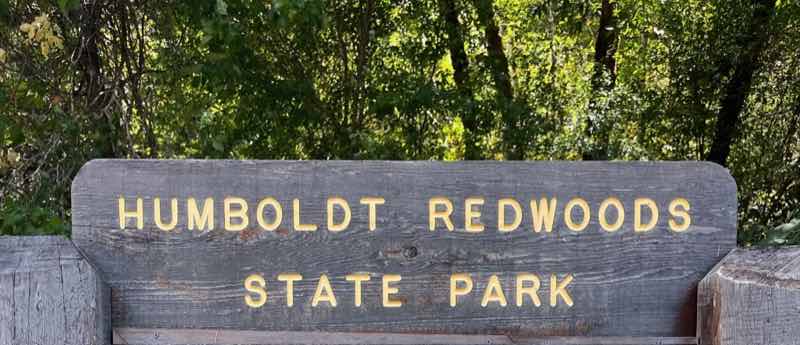
Humboldt Redwoods State Park is an absolute gem of an area nestled in Northern California. The park is located just under 4 hours north of San Francisco and is home to some of the tallest and oldest trees on the planet. It is a paradise for any nature lover but will surely spark awe in just about anyone.
Humboldt Redwoods State Park spans over 53,000 acres and features the largest remaining stand of ancient redwoods. The park is a must-see destination not only in California but throughout the continental United States.
This guide will give you everything you need to know to make the most of your visit. Whether you’re planning a short day trip or a longer stay, you’ll find all the information you need right here.
Table of contents: ()
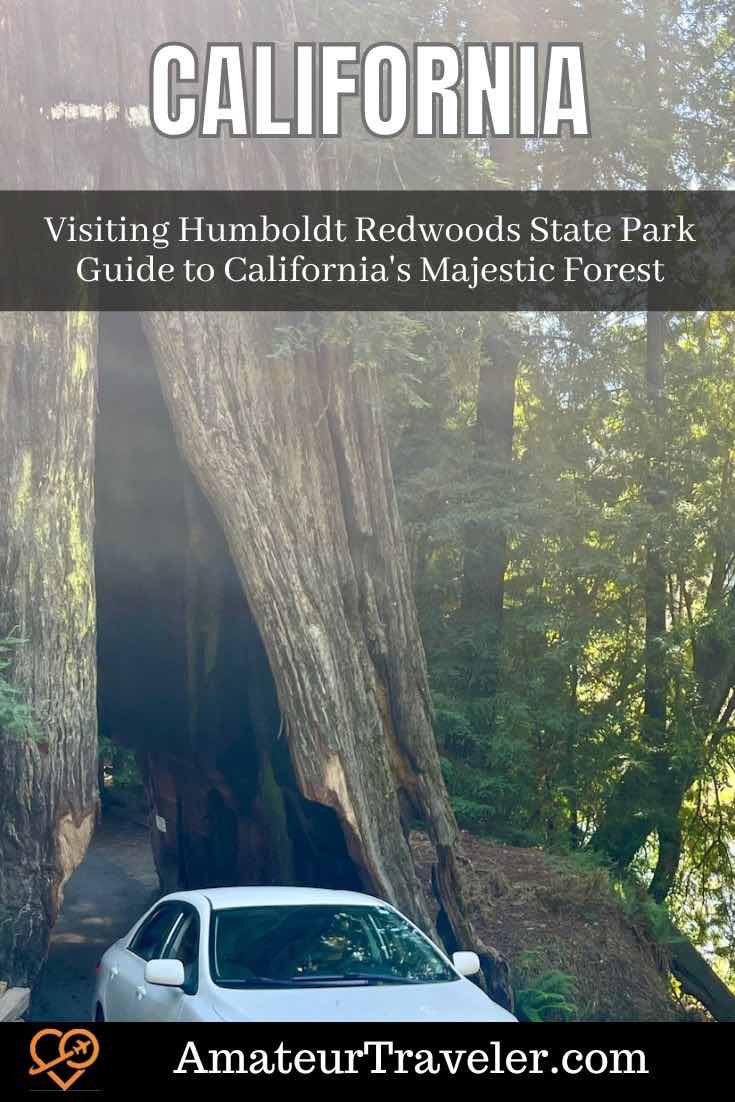
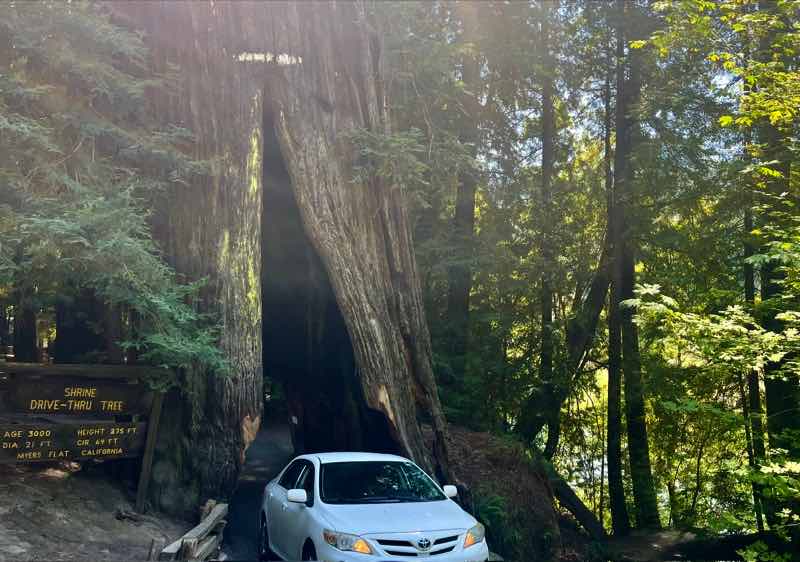
Overview of Humboldt Redwoods State Park
The state park exists due to environmental activism over 100 years ago. European settlers began logging redwoods in the 1850s, clearing land for agriculture. As the lumber industry grew, many believed preserving the massive trees was more valuable than cutting them down. In 1918, the Save the Redwoods League was founded to protect these ancient treasures. Thanks to their efforts, over 200,000 acres of redwood forests have been preserved for future generations.
Redwoods were widespread before the 1850s but now exist only in a 450-mile strip along the Pacific from central California to southern Oregon. Fossil records show they were once found in Europe, Asia, and throughout North America. The tree species is from the Jurassic age, and it’s hard not to picture dinosaurs walking with these giants.
We chose to visit Humboldt Redwoods State Park on our 7-day California road trip because it is one of the furthest south of any of the Redwood state or national parks, and it is still quite large. In contrast, the southernmost visitor center in Redwood National Park is 5.5 hours away from San Francisco, compared to Humboldt’s, which is just 3.75 hours away.
The park is home to various mammals, including raccoons, skunks, black bears, and Roosevelt elk. The one we encountered the most in the area was the banana slug, North America’s largest slug. I wasn’t personally a fan, but they were harmless enough. The marbled murrelet, a rare bird that nests in old-growth forests, is also found in the park.
The Eel River supports salmon and steelhead trout, but despite its name, there are no eels, only the similar Pacific lamprey. The South Fork Eel River is a relatively shallow and calm river that runs through the park and serves as a favorite watering hole for locals to cool down. It is accessible via multiple parking lots, so definitely bring your swimwear if you’re visiting the park in the heart of summer.
Top Attractions and Activities
Avenue of Giants
The Avenue of the Giants is a spectacular scenic drive that winds through Humboldt Redwoods State Park, offering a mesmerizing journey through one of the world’s most breathtaking landscapes. Stretching for 31 miles along Highway 101, this iconic route is renowned for its towering ancient redwoods and enchanting forest views.
At both the north and south entrances to the Avenue of the Giants, free brochures with a route map and information on all the pull-out spots are available.
You’ll find yourself immersed in a cathedral of nature, with some redwood trees reaching heights of over 350 feet and having diameters up to 20 feet. Some over 2,500 years old, these behemoths create a canopy that filters sunlight into a soft, ethereal glow, enhancing the sense of awe and tranquility.
The drive provides numerous pull-outs and scenic stops where you can get out, stretch your legs, and take in the grandeur of these colossal trees up close. There are several opportunities to walk deep into the groves, though you may get a crick in your neck from trying to see the tops of these trees.
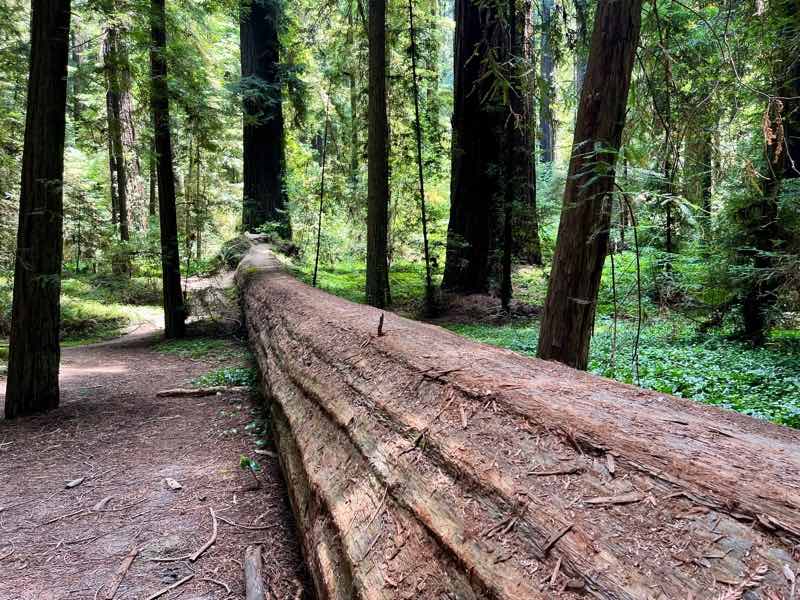
Founders Grove
Founders’ Grove is located off the Avenue of Giant’s Road. Founders’ Grove Nature Loop is a 0.6-mile, 30-minute self-guided trail with a level path. It features the Founders’ Tree, dedicated to the Save the Redwoods League founders, and the Dyerville Giant, a 362-foot redwood that fell in 1991 and enriches the forest ecosystem. Begin at the Founders’ Grove parking area at Avenue of the Giants, mile marker 20.5, about 4 miles north of the park headquarters.
- Get a Car Rental
- Buy Travel Insurance
- Search for Great Tours HERE
- Book Your Accommodation HERE
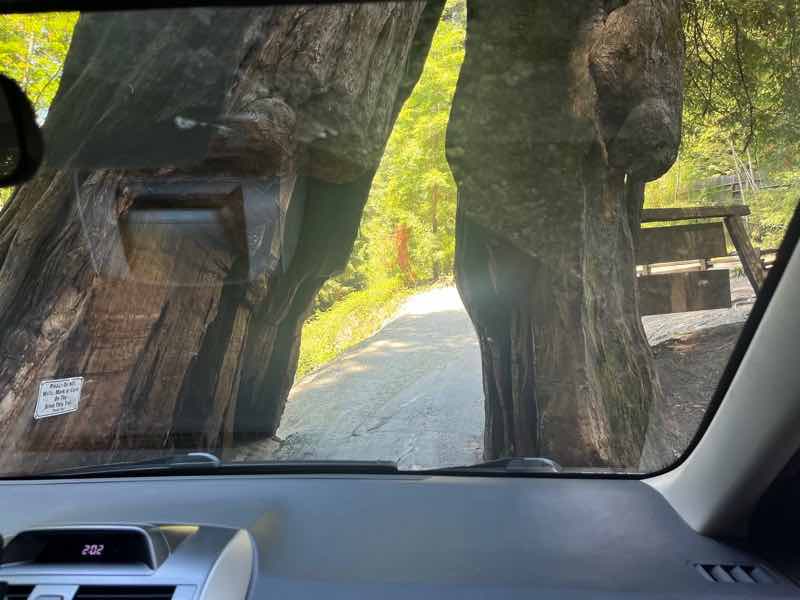
Shrine Drive-Thru Tree
The Shrine Drive-Thru Tree is a quirky roadside attraction where visitors can actually drive through the base of a giant redwood that claims to be around 3,500 years old. Loggers left it alone in the 1800s because the tree appeared to have been struck by lightning, which damaged it enough that they thought the wood wouldn’t be any good.
Entrance to this tiny attraction is $15 per car. Most SUVs probably wouldn’t fit, and definitely no mini-vans or trucks. Our sedan even made me nervous. There’s also a downed redwood that you can drive your car on top of before backing out (honestly, it’s less than thrilling but still makes you appreciate the size of the tree). There’s a small playground carved from the old bases of downed trees that kids might enjoy stretching their legs at.
Hiking Trails
There are four hikes that would be considered moderately difficult. They vary between 2-7.5 miles long with varying degrees of elevation gains. These trails are: Bull Creek Trail North, Bull Creek Trail North and South Loop, River Trail North Section, and the Johnson Prairie Trail. For the really experienced and in-shape hikers, the park also has a handful of 10+ mile hiking trails with varying degrees of elevation gains.
If hiking is important to you, plan your visit between mid-June and early September. During those dates, the park installs summer bridges that allow access to the backcountry, including some of the hikes listed above.
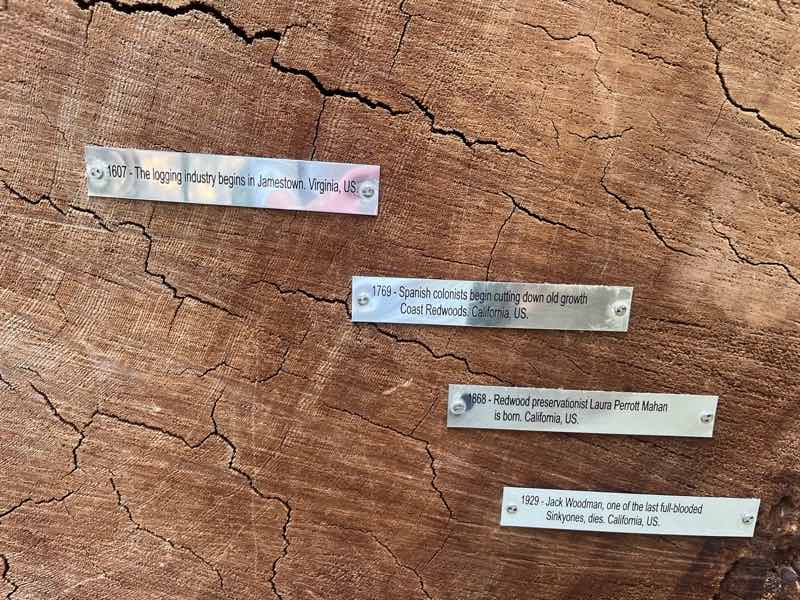
Family-Friendly Activities
Humboldt Redwoods State Park is a great place for a family to visit, especially in summer. The park rangers run a daily calendar of special events throughout the warm months, including nature walks, outdoor presentations, and stargazing nights, during which Humboldt astronomers teach students young and old how to spot wonders in the sky.
The park also has two visitor centers with interactive exhibits about its history and wildlife. While I’ve admittedly seen bigger and better-equipped visitor centers, both would be sufficient to entertain kiddos for a couple of hours. They would be an especially great way to escape the heat on a hot summer day.
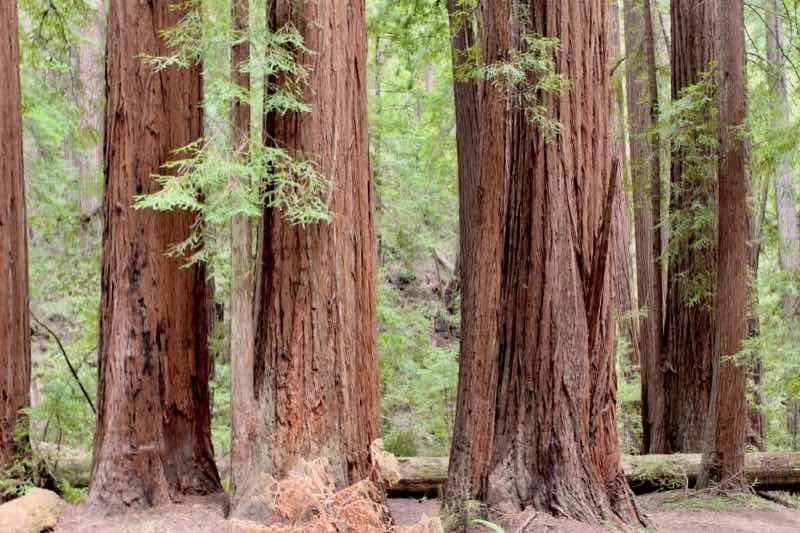
Planning Your Visit
Best Time to Visit Humboldt Redwoods State Park
We visited in the middle of July, and while the park was crowded, the enormous trees provided cover from the hot California sun. Summer temperatures routinely reach the 80s and 90s, but they cool down in the evenings if you’re camping.
If you’d like to avoid the crowds, spring and fall are perfect for visiting the park. Spring (April to June) offers mild temperatures and fewer crowds, making it perfect for hiking and exploring. Fall (September to November) provides beautiful foliage and comfortable weather.
While winter would be quieter in terms of crowds, temperatures can reach the 20s and 30s, and conditions can be cold and muddy.
Seasonal Weather and Conditions
Spring and fall typically bring pleasant temperatures ranging from 50°F to 70°F. Summer temperatures range from 70°F to 90°F, with occasional fog. Winter temperatures range from 40°F to 60°F, with possible rain, snow, and generally cooler conditions, especially in higher elevations.
How to Get There
The park is located off U.S. Highway 101 in Northern California. If driving from San Francisco, take I-580 and US-101 North, which takes a little under 4 hours if you get out of San Francisco without much traffic (admittedly a pretty big feat). From Eureka, the park is roughly 30 minutes south on US-101.
For those flying in, the nearest airports are in Eureka and Arcata, followed by a drive to the park. These airports are smaller and likely to be more expensive than flying into any of the three international airports in the Bay area.
Entrance Fees and Permits
There is a $10 day-use fee per vehicle, and camping fees will vary. Passes can be purchased at the park entrance or online through the California State Parks website. If your yearly calendar has multiple California State Parks penciled in, I would get an annual pass, as you’ll save some money.
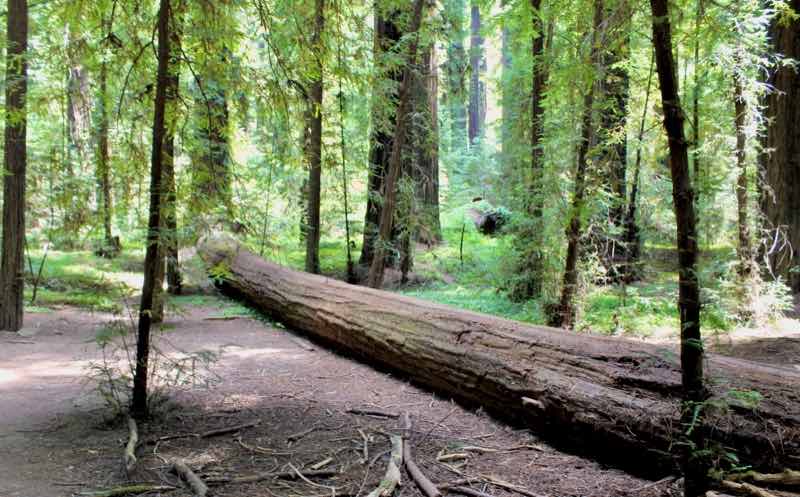
Tips for Visiting
You’re in the wilderness, so there is a risk of poison ivy in the park. The old saying “Leaves of three, let them be!” is in full effect at this park. The risk of encountering the plant is higher in the lush summer months, but even in the winter, the bare limbs can give you a rash.
Sorry Fido, dogs are not allowed on any of the trails in the park. They are allowed in the campgrounds and several of the picnic areas if they remain on a leash. But if you’re planning to hike with your four-legged friend, you’ll have to leave the park to do so. If you’re just driving through the park for a couple of hours, they’ll enjoy sticking their head out the window on the Avenue of Giants Drive.
The park is located in bear country, so if you are staying the night or doing one of the more remote hikes, make sure you take precautions, like storing food and trash in an animal-proof container.
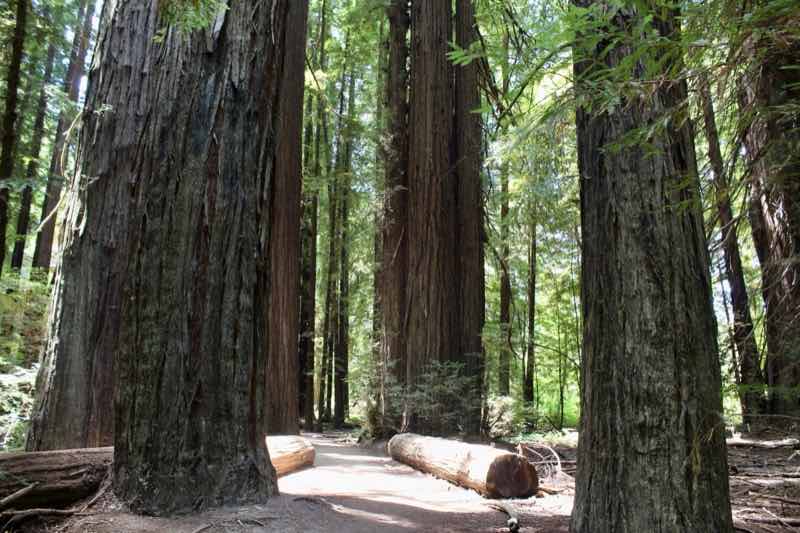
Camping & Lodging
If you are interested in camping in the actual park, it’s a good idea to book your campsite six months in advance (i.e., as soon as the sites are available).
Albee Creek Campground
Albee Creek Campground is open from Memorial Day to Labor Day only. It’s close to several hiking and mountain biking trails. Swimming is available 4 miles east on the South Fork of the Eel River while wading is allowed in Bull Creek or Albee Creek.
Hidden Springs Campground
Typically open from Memorial Day to the end of September, Hidden Springs Campground offers 154 sites on a forested hillside 5 miles south of the visitor center, near Myers Flat. The South Fork of the Eel River is a short walk away.
Burlington Campground
Burlington Campground operates year-round if you’re visiting in the spring or fall. It features 57 sites in a redwood grove near the South Fork of the Eel River, where you can fish and swim. A summer bridge across the river provides access to hiking trails.
We planned our trip only two months out, so all the campsites for the weekend we were visiting were full. Several towns near Humboldt Redwoods have accommodations, the largest of which is Redway. Redway has a full-service grocery store and other small-town amenities but isn’t particularly stunning in its own right.
We opted to stay about 30 miles away and over a mountain in Shelter Cove, a tiny coastal town on California’s Lost Coast. The temperatures were about 30 degrees cooler than in the redwoods, which was perfect in July. Lodging options in Shelter Cove are plentiful, and almost all of them have stunning views of the sea.
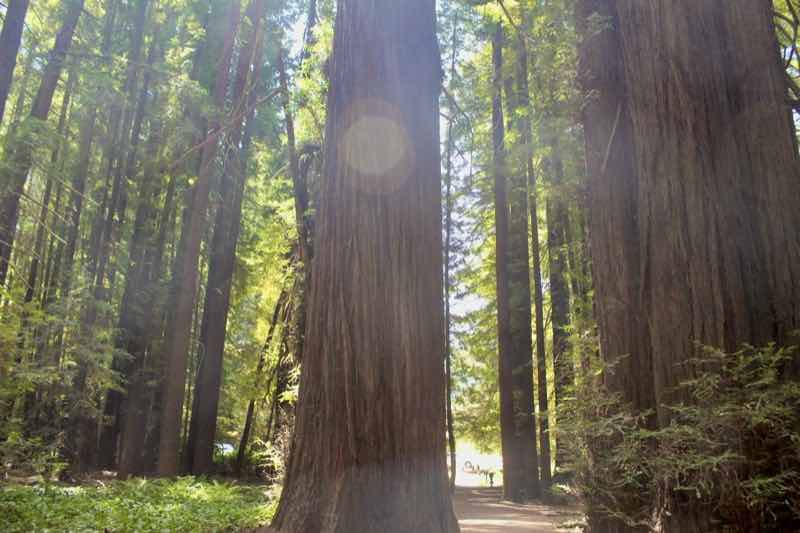
Conclusion
Humboldt Redwoods State Park offers an unforgettable experience with its awe-inspiring trees, diverse wildlife, and stunning landscapes. It’s perfect to explore over the course of multiple days or just a couple of hours if you’re short on time. Whether you’re marveling at the towering redwoods along the Avenue of Giants, enjoying a hike through the old groves, or becoming a junior ranger, the park provides something for everyone.
As this is one of California’s most cherished natural wonders, make sure to plan ahead for accommodations and camping and check seasonal weather to make the most of your visit. With its rich history and natural beauty, Humboldt Redwoods State Park is truly a must-see destination


